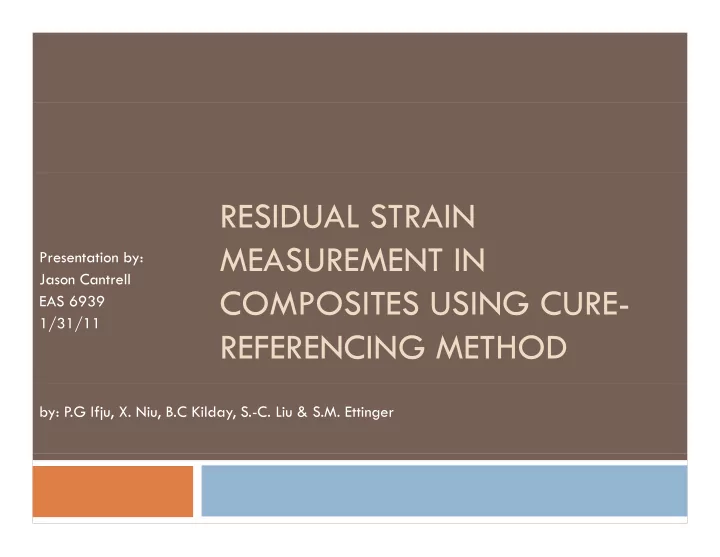

RESIDUAL STRAIN MEASUREMENT IN Presentation by: Jason Cantrell COMPOSITES USING CURE- COMPOSITES USING CURE EAS 6939 1/31/11 REFERENCING METHOD by: P.G Ifju, X. Niu, B.C Kilday, S.-C. Liu & S.M. Ettinger
Background g Residual stress results from thermal mismatch between fiber and matrix Also results from chemical shrinkage of matrix on polymerization l i i Thermal characteristics of composites are directional and depend upon fiber orientation. and depend upon fiber orientation. These behaviors influence the fiber and matrix differently and are based upon fiber orientation angle. If thermal and chemical characteristics are not taken into consideration during stacking the laminate may warp significantly warp significantly.
Materials Tested AS4/3501-6 graphite/epoxy and plain weave AS4/3501 6 graphite/epoxy and plain weave fabric 4 cases tested 4 cases tested Unidirectional - [0 16 ] T Cross ply [0 /90 /0 /90 ] Cross-ply [0 2 /90 2 /0 2 /90 2 ] S Angle-ply [0 2 /45 2 /0 2 /45 2 ] S 18-ply woven panel 18 l l
Specimen Preparation p p A diffraction grating is attached to the composite to view chemical shrinkage after solidification of the matrix t i The grating in a stress-free state is known and serves as reference f The grating is applied and cured with the composite then observed using moiré interferometry to view residual stresses.
Moiré Interferometry Measures orthogonal in-plane di displacements, U and V l U d V Two beams of light are impinged upon specimen and react forming an interference react forming an interference pattern consisting of light and dark bands This is known as reference grating or virtual reference grating because it is just lighting The specimen grating and the Th d h fixed reference grating interact to form the moiré pattern
Experiments at Elevated Temperature p p Specimen must be heated to cure temperature to Specimen must be heated to cure temperature to remove residual strains that are due to contraction. Residual strains left are due to chemical shrinkage and stress relaxation.
Unidirectional Fiber U field pattern (Fiber/ U field pattern (Fiber/ x-direction) is nearly zero V field pattern (Transverse/ y- / direction) is quite large A large compressive strain was found in y- direction
Unidirectional Fiber Strain transverse to Strain transverse to fiber direction at the cure temperature was not zero. Demonstrates that a significant portion of residual strain in related to chemical shrinkage in matrix
Cross-Ply Composite y p Gradients in both fields are nearly equal. As expected because of equal number of plies in 0 deg and 90 plies in 0-deg and 90- deg direction No detectable residual No detectable residual strain due to chemical shrinkage
Angle-Ply Composite g y p U field gradient is small, U field gradient is small, consistent with direction fiber dominance. V gradient is inclined, indicating strong vertical and horizontal gradients. d h i l di Both normal and shear strains did not return to strains did not return to zero.
Conclusion This paper covers the experimental techniques used This paper covers the experimental techniques used to measure strain due to residual stresses Subsequent papers describe how to calculate Subsequent papers describe how to calculate stresses with Laminate theory Residual Strains and Thermal Analysis are covered Residual Strains and Thermal Analysis are covered in Chapter 3 of “Design and Optimization of Laminated Composite Materials”
References Ifju, P. G., et al. "Residual Strain Measurements in Composites Using Cure-referencing Method." Experimental " Mechanics Vol. 40.No. 1 (2000): 22-30. Key phases- composite materials, residual stress, cure- y p p referencing method, moiré interferometry Gurdal, Zafer, Raphael T. Haftka and Prabhat Hajela. Design and Optimization of Laminated Composite Materials. g p p New York: John Wiley & Sons, Inc., 1999. Jenkins, C. H., ed. Manual on Experimental Methods for Mechanical Testing of Composites. 2nd. Lithburn: The g p Fairmont Press, Inc., 1998. Dr. Peter Ifju
Recommend
More recommend